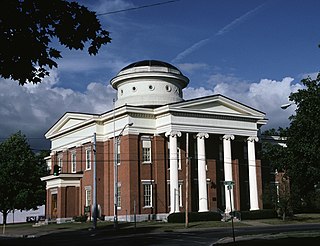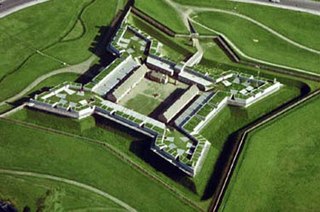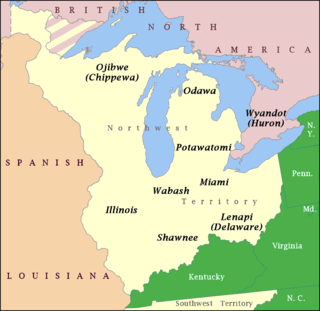Related Research Articles

Oriskany is a village in Oneida County, New York, United States. The population was 1,400 at the 2010 census. The name is derived from the Iroquois word for "nettles".

Rome is a city in Oneida County, New York, United States, located in the central part of the state. The population was 32,127 at the 2020 census. Rome is one of two principal cities in the Utica–Rome Metropolitan Statistical Area, which lies in the "Leatherstocking Country" made famous by James Fenimore Cooper's Leatherstocking Tales, set in frontier days before the American Revolutionary War. Rome is in New York's 22nd congressional district.

Thayendanegea or Joseph Brant was a Mohawk military and political leader, based in present-day New York and, later, Brantford, in what is today Ontario, who was closely associated with Great Britain during and after the American Revolution. Perhaps the best known Native American of his generation, he met many of the most significant American and British people of the age, including both United States President George Washington and King George III of Great Britain.

The 1779 Sullivan Expedition was a United States military campaign during the American Revolutionary War, lasting from June to October 1779, against the four British-allied nations of the Iroquois. The campaign was ordered by George Washington in response to the 1778 Iroquois and British attacks on the Wyoming Valley, German Flatts, and Cherry Valley. The campaign had the aim of "taking the war home to the enemy to break their morale." The Continental Army carried out a scorched-earth campaign in the territory of the Iroquois Confederacy in what is now western and central New York.

The Battle of Oriskany was a significant engagement of the Saratoga campaign of the American Revolutionary War, and one of the bloodiest battles in the conflict between Patriot forces and those loyal to Great Britain. On August 6, 1777, several hundred of Britain's Indigenous allies, accompanied by Loyalists of the King's Royal Regiment of New York and the British Indian Department, ambushed a Patriot militia column which was marching to relieve the siege of Fort Stanwix. This was one of the few battles in which the majority of the participants were American colonists. Patriots and allied Oneidas fought against Loyalists and allied Iroquois and Mississaugas. No British regulars were involved; however, a detachment of Hessians was present.

Fort Stanwix was a colonial fort whose construction commenced on August 26, 1758, under the direction of British General John Stanwix, at the location of present-day Rome, New York, but was not completed until about 1762. The bastion fort was built to guard a portage known as the Oneida Carry during the French and Indian War. Fort Stanwix National Monument, a reconstructed structure built by the National Park Service, now occupies the site.

The Oneida people are a Native American tribe and First Nations band. They are one of the five founding nations of the Iroquois Confederacy in the area of upstate New York, particularly near the Great Lakes.

Adam Frederick Helmer, also known as John Adam Frederick Helmer and Hans Adam Friedrich Helmer, was an American Revolutionary War hero among those of the Mohawk Valley and surrounding regions of New York State. He was made nationally famous by Walter D. Edmonds' popular 1936 novel Drums Along the Mohawk with its depiction of "Adam Helmer's Run" of September 16, 1778, to warn the people of German Flatts of the approach of Joseph Brant and his company of Indians and Tories.
Onaquaga was a large Iroquois village, located on both sides of the Susquehanna River near present-day Windsor, New York. During the American Revolutionary War, the Continental Army destroyed it and nearby Unadilla in October 1778 in retaliation for British and Iroquois attacks on frontier communities.
Walter Butler was an American-born Loyalist military officer during the American Revolutionary War. He was born near Johnstown, New York, the son of John Butler, a native agent who worked for Sir William Johnson. Walter Butler studied law, and became a lawyer in Albany, New York prior to the American Revolution. He was killed in battle in 1781.

The Treaty of Canandaigua, also known as the Pickering Treaty and the Calico Treaty, is a treaty signed after the American Revolutionary War between the Grand Council of the Six Nations and President George Washington representing the United States of America.
Johannes Justus Schuyler was a Tory with patriot roots, who was used by American General Benedict Arnold to repel the British and Indian forces of Colonel Barry St. Leger and Joseph Brant from their siege of Fort Stanwix following the Battle of Oriskany during the American Revolution.

The Oneida Carry was an important link in the main 18th century trade route between the Atlantic seaboard of North America and interior of the continent. From Schenectady, near Albany, New York on the Hudson River, cargo would be carried upstream along the Mohawk River using boats known as bateaux. At the location at modern-day Rome, New York, the cargo and boats would be portaged one to four miles overland to Wood Creek. This portage, which the Haudenosaunee called De-o-Wain-Sta, was known as the Oneida Carry or The Great Carrying Place in English, and as Trow Plat in Dutch. After relaunching into Wood Creek, the bateaux would navigate downstream to Oneida Lake, the Oswego River, and ultimately Lake Ontario at Oswego. Lake Ontario was the gateway to all the Great Lakes stretching another thousand miles inland.

The Northwestern Confederacy, or Northwestern Indian Confederacy, was a loose confederacy of Native Americans in the Great Lakes region of the United States created after the American Revolutionary War. Formally, the confederacy referred to itself as the United Indian Nations, at their Confederate Council. It was known infrequently as the Miami Confederacy since many contemporaneous federal officials overestimated the influence and numerical strength of the Miami tribes based on the size of their principal city, Kekionga.

The northern theater of the American Revolutionary War after Saratoga consisted of a series of battles between American revolutionaries and British forces, from 1778 to 1782 during the American Revolutionary War. It is characterized by two primary areas of activity. The first set of activities was based around the British base of operations in New York City, where each side made probes and counterprobes against the other's positions that sometimes resulted in notable actions. The second was essentially a frontier war in Upstate New York and rural northern Pennsylvania that was largely fought by state militia companies and some Indian allies on the American side, and Loyalist companies supported by Indians, British Indian agents, and occasionally British regulars. The notable exception to significant Continental Army participation on the frontier was the 1779 Sullivan Expedition, in which General John Sullivan led an army expedition that drove the Iroquois out of New York. The warfare amongst the splinters of the Iroquois Six Nations were particularly brutal, turning much of the Indian population into refugees.

Brant's Volunteers, also known as Joseph Brant's Volunteers, were an irregular unit of Loyalist and indigenous volunteers raised during the American Revolutionary War by Mohawk war leader, Joseph Brant, who fought on the side of the British on the frontier of New York. Being military associators, they were not provided soldiers' uniforms, weapons, or pay by the British government, and survived by foraging and plundering.

The Treaty of Fort Stanwix was a treaty finalized on October 22, 1784, between the United States and Native Americans from the six nations of the Iroquois League. It was signed at Fort Stanwix, in present-day Rome, New York, and was the first of several treaties between Native Americans and the United States after the American victory in the Revolutionary War.

The siege of Fort Stanwix began on August 2, 1777 and ended on August 22, 1777. Fort Stanwix, at the western end of the Mohawk River Valley, was a primary defense point for the Continental Army against the British and indigenous forces aligned against them during the American Revolutionary War. The fort was occupied by Continental Army forces from New York and Massachusetts under the command of Colonel Peter Gansevoort. The besieging force was composed of British regulars, Loyalist soldiers, Hessians, and indigenous warriors, under the command of Brigadier General Barry St. Leger. St. Leger's expedition was a diversion in support of Lieutenant General John Burgoyne's campaign to take control of the Hudson River Valley to the east.
Tyonajanegen was an Oneida woman who fought in the August 6, 1777 Battle of Oriskany during the American Revolutionary War. Armed with two pistols, she rode into battle and fought alongside her husband, Han Yerry, and her son, Cornelius. Tyonajanegen helped her husband reload his gun after a musket ball struck him in the wrist. After the battle she rode on horseback to bring news of the outcome to local rebels and Indians.
Han Yerry is also known by Honyere Doxtator and his native name, Tewahangarahken. As a child, Han Yerry lived with a German-Dutch couple, who educated him and taught him the white people's culture. Over his life, he was a warrior, war chief, commissioned American Army officer, farmer, rancher, and caterer. He made a name for himself in the American Revolutionary War and is one of three great ancestors of Oneida people who served as commissioned officers in the war. Hon Yerry received 1,800 acres in land grants for his service. He was a gentle man, distinguished soldier, leader, man of his word, and heroic.
References
- ↑ Draper, Lyman (1 July 2012). "Oneida Interviews". Native Heritage Project. Retrieved 8 October 2019.
- ↑ "Few Accounts Exist of Oneida Involvement in Revolutionary War". Oneida Indian Nation. Retrieved 8 October 2019.
- ↑ Glatthaar and Martin (2006). Forgotten Allies: The Oneida Indians and the American Revolution. New York: Hill and Wang. pp. 158. ISBN 978-0-8090-4601-0.